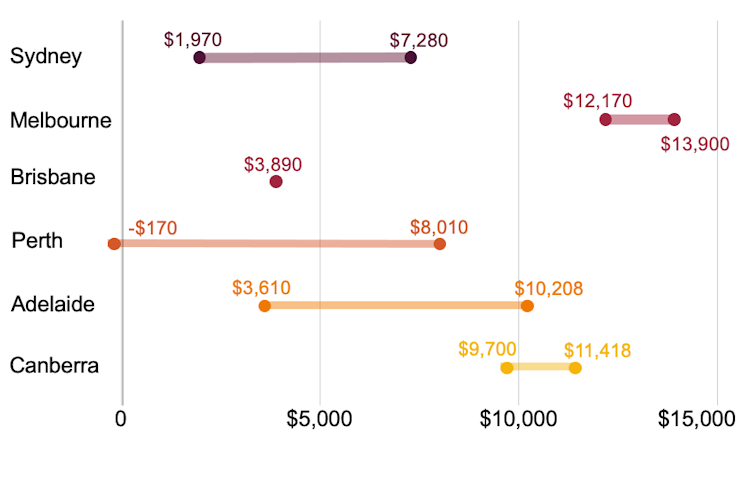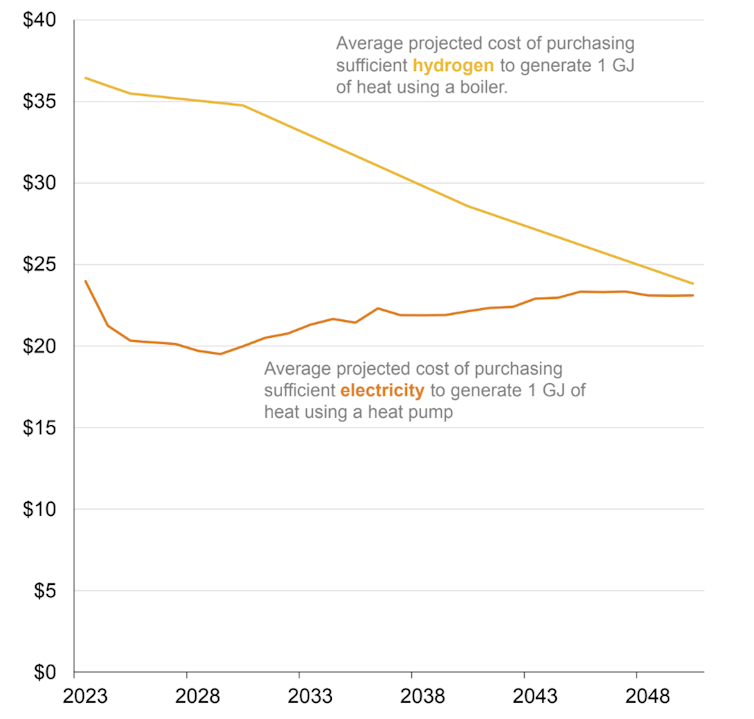Esther Suckling, Grattan Institute
If every Australian household that uses gas went all-electric today, we would ‘save’ more than 30 million tonnes of carbon dioxide emissions over the next 10 years. That’s because there are more than five million households on the gas network, and the avoided emissions per home ranges from 5-25 tonnes over the coming decade, depending on the location.
Most people would spend less money on energy too. Electric appliances use less energy than gas appliances to do the same job, making them cheaper to run.
Our new report shows how much most households can save by switching from gas to electricity for heating, hot water and cooking. The extra cash couldn’t come at a better time: about a quarter of Australian households say they found it difficult to pay their energy bills this year.
But many households face hurdles that stop them, or make it hard for them, to go all-electric. Governments could make it easier for people and bring emissions-reduction targets closer to reality.
Most households save by upgrading to electric

Grattan Institute, Author provided
Households in Melbourne tend to use more gas than those in other mainland capitals, mainly because the winter is so cold. Our report found Melburnians who replace broken gas appliances with electric ones, or move into an all-electric home, could save up to $13,900 over 10 years. Households with rooftop solar will save even more.
It’s a similar story in most parts of Australia except the west, where gas is relatively cheap. This mainly reflects differences in the historical development of the gas markets between the west and east coasts.
Getting off gas could also be good for your health. Several studies link cooking with gas to childhood asthma.
Households face a series of hurdles
Renters make up nearly a third of all households, and they have little or no control over the appliances that are installed. As most electric appliances cost more to buy than gas ones – and the subsequent bill savings flow to tenants – landlords have little incentive to upgrade their properties from gas to all-electric.
Apartment living can increase the level of complexity. Multi-unit dwellings often bundle gas bills into body corporate fees, limiting the occupants’ incentive to go all-electric. There can also be space constraints in these buildings. Centralised electric heat pumps, for example, take up more space than centralised gas water heaters.
Then there are households that simply can’t afford the upgrade. Induction stoves and heat pumps are more expensive than their gas equivalents, by up to a combined $2000. This initial outlay will soon be recovered by cheaper energy bills, but that doesn’t help households that don’t have the cash up-front. The 12 per cent of households that skipped meals to pay their energy bills in the past year are the most likely to remain locked into high gas bills.
Some people also simply prefer cooking with gas. Some think induction cooktops will be no better than the poor-performing electric cooktops they may have used in the distant past. Others haven’t ever heard of a heat pump for hot water.
Here’s how governments can help
Governments, both state and federal, should lower the hurdles on the path to all-electric homes – to reduce people’s cost of living and to cut carbon emissions.
As a first step, state governments should ban new gas connections to homes. In 2021, more than 70,000 households joined the gas network. Trying to shift households off gas while allowing new connections is like pouring water into a bucket with a hole.
Then, governments should provide landlords with tax write-offs on new induction stoves and heat pumps for hot water, for a limited time. After that, they should require every rental property to be all-electric. Governments should pay to upgrade public housing to all-electric, where they are the landlords. And they should pay not-for-profits managing community housing to do the same.
The federal government should help all households to spread the cost of electric appliances over time. It should subsidise banks to offer low-interest loans for home electrification, via the Clean Energy Finance Corporation.
And governments should set out to change people’s preferences, from gas to electric. They should embark on a multi-decade communication campaign, not unlike the campaign to upgrade from analogue to digital television in the early 2000s.
A key challenge will be shifting people’s ideas about the best way to cook. There are precedents. In Gininderry, a new all-electric suburb of Canberra, one developer recruited chefs to run demonstrations on induction cooktops at the display village. The proportion of potential homebuyers willing to consider buying an all-electric home rose from 67 per cent to 88 per cent.
‘Green gas’ is no panacea: electricity is cheaper

Grattan Institute, Author provided
The gas industry has another solution in mind: instead of switching from gas to electricity, it suggests using ‘green gas’ – biomethane or ‘green’ hydrogen. Biomethane is chemically identical to natural gas, but is derived from biological materials such as food waste, sewage or agricultural waste. Green hydrogen is made by using electricity to split water into hydrogen and oxygen.
But both options are too expensive and too far away. Under the most generous of assumptions, green hydrogen will only become cost-competitive with electricity after 2045. And there is not enough biomethane commercially available to replace gas in households.
Meanwhile, more than three million Australian homes already run on electricity alone.
Getting the five million homes that use gas to the same point won’t be easy. But with good policy, it is doable. For households, and the climate, there is much to be gained.
Esther Suckling, Research Associate, Grattan Institute
This article is republished from The Conversation under a Creative Commons licence. Read the original article.
Do you have gas appliances? Would you consider switching to electricity? Why not share your opinion in the comments section below?
Also read: How the electricity bill relief payment works in your state


There is something really fishy about this whole debate which nobody seems prepared to answer, why is gas dearer than electricity produced from the same gas??
We produce only 10% of our electricity from solar and wind which we are told is cheaper but if we elect to buy ‘green energy’ We are charged a premium for it, why?
More and more of our electricity is produced from gas which we are told is more efficient than coal but as we transition to gas powered electricity we are charged more for it, why?
To produce one kWh hour of heating from gas fuelled electricity requires the equivalent of two kWh of gas. That is because the conversion from gas to electricity is only 50% efficient. So why is domestic gas heating dearer than electric heating?
My brother lives in a country which produces electricity from atomic energy, wind and local and imported gas but gas heating is still half the cost of electric heating which is the reverse of Australia one of the world’s biggest gas producers and exporters, so why this pricing disparity?
I think the gas asthma claim is a Phurphy. I was brought up in a country where gas cooking and domestic gas heating combined with coal was almost universal but had lower asthma rates than Australia suffers now. So why?
There are so many aspects of the energy debate that do not make sense that it can only be concluded that we are being played by a greedy energy industry and a complicit government.
Gas is clean and efficient. Put a pot on an electric element and one beside it on gas – and gas wins every time! “SOME” caravan manufacturers are now removing gas altogether from caravans – and using 12V EVERYTHING!!
Good luck with that! We have lived on the road for 11 years now, and I have to have a lot of backup 12V power for my wife’s CPAP machine (360 a/h batteries – 300kw of solar). One full day of rain – and the generator has to come out. Sure – I don’t have lithium batteries, but I have the next best thing – Lead Carbon AGM’s.
We go through a 9Kg bottle of gas over two months, HWS and cooking, and that is $25.
Some of these new “weekend warriors” with their $200,000 “all 12V electric HWS, 12V Washing machine, 12V refrigerator, 12V cooking – ARE IN FOR A BIG SHOCK!!!
Today I was wandering in BCF and looking at the diversity of simple portable gas stoves/cookers. If “we” are destined to be committed to a 100% renewable produced electricity, every home should get one as some are very affordable and convenient for emergency use. Apart from a Federal Minister for Renewable Energy, there are many who believe that the Grid will not be able to meet demand when we are all increasing our demand on it at a rate greater than the storage systems are coming on line.
I also saw the Li-ion battery set adjacent to a Pb-AGM one. Equivalent costing comes in at close to double for the Li-ion alternative.
A week ago at FarmFest locally, the 2KVA Honda generator was on sale at under $2K. The 1KVA was under $1K. A viable and affordable standby system. (There are portable generators at less than half the cost of the Honda, but accuracy and stability of output was dangerously poor along with “making metal” with less than 50 hours as shown in a YouTube real time comparison test.)
The push to get us 100% dependable on electricity amounts to be being driven by a political agenda and not by good science or engineering.
Over the last couple of years, I have converted to all electric by way of solar panels, induction cooking, reverse cycle cooling and heating, and heat pump hot water. My last quarterly electricity bill for summer was $32. Having no use for the gas meter, I rang to have it removed, only to find its removal would cost $987. If I don’t have it removed, I will still be liable for the daily charge of $0.81092 or $48.66 every 60 days. At that rate it will take nearly 3 1/2 years to break even if I pay up front. This may be an area where the Government can help. I won’t hold my breath.
The conversation = blah, blah, blah l!!!!
@Tood – “Blah, Blah, Blah!!
Shows how arrogant you are that 80% of Australians are suffering with major household costs and your reaction is “Blah, Blah, Blah!!”
If you “even think” that solar is going to take the place of coal fired power – you are dreaming! Close down coal fired power stations – and you WILL go without, cars, steel, houses, manufacturing, jobs, jobs and jobs!
Peter, I took Toods comment as giving “The Conversation” the respect that it deserves. Nil.
The Conversation is a strong left wing channel that supports the destruction of our legacy reliable electricity supply systems in favour of the expensive renewable systems that need all three systems (solar, wind and battery) to be able to equal the old coal systems.
The truth be known and it is acknowledged that even if every presently gas cooking and hotwater user in Australia discarded their gas before the end of this month, it would make absolutely no difference to either Australia’s or the planet’s climate. No difference.
Instead, the cost for many households would be well over $1,000 in the appliance alone before the changes in cooking utensils is included (the big push is from induction electric bench tops – a system that needs iron bottomed cook ware (ceramic and aluminium do not work)). And with increasing electricity costs, there is no certainty of any overall savings in domestic costs.
If due to cost of living pressures people are skipping meals to pay their gas bills, there is no way that they could afford to convert to an electric cooking system of the type being promoted.
Today I filled a gas bottle that had done my cooking for over 6 months at the cost of $24.99.
This is a purely political push from The Grattan Institute broadcast through the very left wing Conversation. Neither the organisation nor this media are genuinely concerned about building a strong future Australia but determined to undermine the strong industries that have built our country.
To even suggest that the future could be with biogenerated methane and “green” hydrogen shows how far removed from intelligence these Grattan Institute “think tanks” really are.
Methane is coming from landfill near us now and out of the sewerage treatment pants all the time, (you can built your own but the local Council won’t like you doing so), but the infrastructure is not in place now.
As far as “green”hydrogen goes, it only works when Government Grants and subsidies are thrown at it and it still used more energy to produce than it can deliver from the final product.
There is an old saying that is worth remembering here and that is “Never put all your eggs in the same basket”.
I am reminded of the Solar Panel salesman who contacted me to quote on solar power from our rooftop. The cost of an average system at $4000 would not pay for itself within 10 years and the panels would probably be inefficient and need replacing at that time. Why would I want to instal them.
If Australia should ever become a major manufacturing nation in the future we will need REAL power generation, no some mamba pamby solar farm or wind generator. Give us nuclear power instead.
Looking at the breakdown of my recent power bill increase
notice I see that the greatest price jump is not for the electricity but for the service charge (poles, wires and meter). This means that even if you use less electricity or instal solar your bill still goes up. Nothing cynical about the power companies pricing!
Anyone seriously interested in how our government’s including the present ‘people’s government’ colluded with the gas companies to rip off the people on gas prices should read Rex Patrick in Michael West Media available online via Google. Rex Patrick is trying to get a deal made between the government and the gas producers made public. The government is taking legal action to stop it, why? Read Rex Patrick’s account.
It is obvious that the writer of this piece lives in the central city area. Anyone who lives in outer suburban and regional areas is aware that gas is the only reliable source of energy. Grid supplied electricity in these areas is unreliable due to wind blowing trees or branches across lines, the power often off for hours, and often days. As for using Solar, the cost of panels (initial subsided but not the replacement or disposal), and as for batteries the initial cost, disposal and replacement cost are not being addressed. The other issue with batteries (particularly Lithium) is the risk of flammability due to overheating and possible damage. The fires cannot be contained by water or normal extinguishers, due to the regenerative and explosive nature of the fires and the gases they emit. Start talking to fire services and insurance companies about vehicle and house fires that are currently occurring with increasing regularity.
Idealism is a wonderful thing, but you must also be realistic. Many people, or so called experts with agendas do not look at the whole life of products from the planning, the acquisitions of materials through to the disposal and cleanups, together with the impacts along the way. some things may may all right or easily controlled in small quantities but impossible to deal with in large scale operations.
Obviously people in these think tanks like the “Gratton Institute” do not operate in the real world, only the theoretical world.